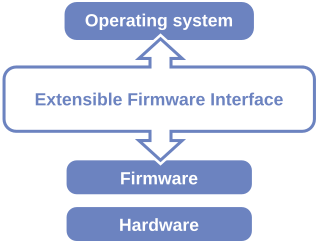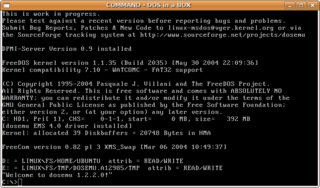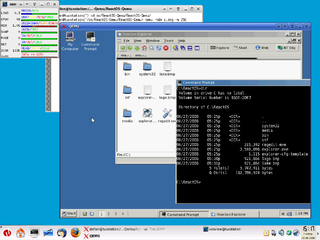
Backward compatibility is a property of a system, product, or technology that allows for interoperability with an older legacy system, or with input designed for such a system, especially in telecommunications and computing.

Industry Standard Architecture (ISA) is the 16-bit internal bus of IBM PC/AT and similar computers based on the Intel 80286 and its immediate successors during the 1980s. The bus was (largely) backward compatible with the 8-bit bus of the 8088-based IBM PC, including the IBM PC/XT as well as IBM PC compatibles.

The Intel 486, officially named i486 and also known as 80486, is a higher-performance follow-up to the Intel 386 microprocessor. The i486 was introduced in 1989 and was the first tightly pipelined x86 design as well as the first x86 chip to use more than a million transistors, due to a large on-chip cache and an integrated floating-point unit. It represents a fourth generation of binary compatible CPUs since the original 8086 of 1978.

x86 is a family of instruction set architectures initially developed by Intel based on the Intel 8086 microprocessor and its 8088 variant. The 8086 was introduced in 1978 as a fully 16-bit extension of Intel's 8-bit 8080 microprocessor, with memory segmentation as a solution for addressing more memory than can be covered by a plain 16-bit address. The term "x86" came into being because the names of several successors to Intel's 8086 processor end in "86", including the 80186, 80286, 80386 and 80486 processors.
Real mode, also called real address mode, is an operating mode of all x86-compatible CPUs. The mode gets its name from the fact that addresses in real mode always correspond to real locations in memory. Real mode is characterized by a 20-bit segmented memory address space and unlimited direct software access to all addressable memory, I/O addresses and peripheral hardware. Real mode provides no support for memory protection, multitasking, or code privilege levels.
In computer architecture, 64-bit integers, memory addresses, or other data units are those that are 64 bits wide. Also, 64-bit central processing unit (CPU) and arithmetic logic unit (ALU) architectures are those that are based on processor registers, address buses, or data buses of that size. 64-bit microcomputers are computers in which 64-bit microprocessors are the norm. From the software perspective, 64-bit computing means the use of machine code with 64-bit virtual memory addresses. However, not all 64-bit instruction sets support full 64-bit virtual memory addresses; x86-64 and ARMv8, for example, support only 48 bits of virtual address, with the remaining 16 bits of the virtual address required to be all 0's or all 1's, and several 64-bit instruction sets support fewer than 64 bits of physical memory address.
In computing, protected mode, also called protected virtual address mode, is an operational mode of x86-compatible central processing units (CPUs). It allows system software to use features such as virtual memory, paging and safe multi-tasking designed to increase an operating system's control over application software.

x86-64 is a 64-bit version of the x86 instruction set, first released in 1999. It introduced two new modes of operation, 64-bit mode and compatibility mode, along with a new 4-level paging mode.

Windows 9x is a generic term referring to a series of Microsoft Windows computer operating systems produced from 1995 to 2000, which were based on the Windows 95 kernel and its underlying foundation of MS-DOS, both of which were updated in subsequent versions. The first version in the 9x series was Windows 95, which was succeeded by Windows 98 and then Windows Me, which was the last version of Windows on the 9x line.
In the 80386 microprocessor and later, virtual 8086 mode allows the execution of real mode applications that are incapable of running directly in protected mode while the processor is running a protected mode operating system. It is a hardware virtualization technique that allowed multiple 8086 processors to be emulated by the 386 chip; it emerged from the painful experiences with the 80286 protected mode, which by itself was not suitable to run concurrent real mode applications well.

The Unified Extensible Firmware Interface (UEFI) is a specification that defines a software interface between an operating system and platform firmware. UEFI replaces the legacy Basic Input/Output System (BIOS) firmware interface originally present in all IBM PC-compatible personal computers, with most UEFI firmware implementations providing support for legacy BIOS services. UEFI can support remote diagnostics and repair of computers, even with no operating system installed.

DOSEMU, stylized as dosemu, is a compatibility layer software package that enables DOS operating systems and application software to run atop Linux on x86-based PCs.

QEMU is a free and open-source emulator and virtualizer that can perform hardware virtualization.
Virtual DOS machine (VDM) refers to running 16-bit/32-bit DOS under 32 bit Windows via COMMAND.COM.
In computing, Windows on Windows is a compatibility layer of 32-bit versions of the Microsoft Windows NT family of operating systems that extends NTVDM to provide limited support for running legacy 16-bit programs written for Windows 3.x or earlier. There is a similar subsystem, known as WoW64, on 64-bit Windows versions that runs 32-bit programs.

The Ensoniq AudioPCI is a PCI-based sound card released in 1997. It was Ensoniq's last sound card product before they were acquired by Creative Technology. The card represented a shift in Ensoniq's market positioning. Whereas the Soundscape line had been made up primarily of low-volume high-end products full of features, the AudioPCI was designed to be a very simple, low-cost product to appeal to system OEMs and thus hopefully sell in mass quantities.
Binary-code compatibility is a property of computer systems meaning that they can run the same executable code, typically machine code for a general-purpose computer CPU. Source-code compatibility, on the other hand, means that recompilation or interpretation is necessary before the program can be run.
In computing on Microsoft platforms, WoW64 is a subsystem of the Windows operating system capable of running 32-bit applications on 64-bit Windows. It is included in all 64-bit versions of Windows—including Windows XP Professional x64 Edition, IA-64 and x64 versions of Windows Server 2003, as well as x64 versions of Windows Vista, Windows Server 2008, Windows 7, Windows 8, Windows Server 2012, Windows 8.1, Windows 10, Windows Server 2016 and Windows Server 2019, as well as ARM64 versions of Windows 10 and Windows Server 2022. In Windows Server 2008 R2 Server Core, it is an optional component. It is not available in Windows Nano Server variants. WoW64 aims to take care of many of the differences between 32-bit Windows and 64-bit Windows, particularly involving structural changes to Windows itself.
Tao ExDOS is an emulator software application designed to allow users of old MS-DOS applications to run these applications on new operating systems such as Windows 10, Windows 8, Windows 7, Windows Vista, Windows XP, Windows 2000, and Windows Terminal Server.

SeaBIOS is an open-source implementation of a 16-bit x86 BIOS, serving as a freely available firmware for x86 systems. Aiming for compatibility, it supports standard BIOS features and calling interfaces that are implemented by a typical proprietary x86 BIOS. SeaBIOS can either run on bare hardware as a coreboot payload, or can be used directly in emulators such as QEMU and Bochs.










